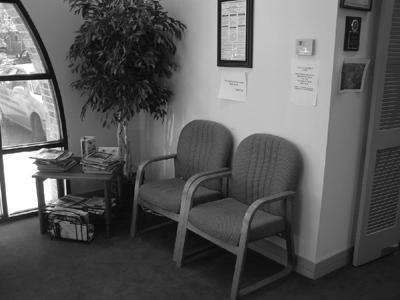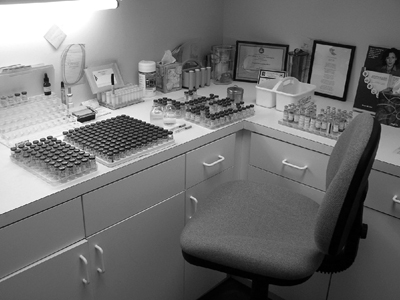2 Preparing an office to perform skin testing utilizing the intradermal dilutional testing (IDT) and modified quantitative testing (MQT) techniques requires time, training, personnel, space, equipment, and supplies. For most physicians, skin testing is added to an existing practice and office space. Because offices and practices vary, there are no hard-and-fast rules that apply to this preparation. Some basic information can help make the setup process more efficient and successful. If a current staff member is going to be designated as the allergy assistant, getting his or her input into preparing the allergy area and designing the layout may facilitate smoother and more efficient daily procedures. This is especially true if the staff member has previous allergy practice experience. In general, preparing an office for the incorporation of allergy requires the proper personnel, space, and equipment. This chapter provides practical information and advice to help the physician with this process.1 Like most other endeavors in medical practice, proper education is the first step in achieving optimal results. A physician needs a good understanding of the day-to-day processes involved in providing allergy services. Many resources are available to the physician to obtain the proper training. Many nationally accredited organizations, such as the American Academy of Otolaryngic Allergy (AAOA), offer allergy courses. The AAOA provides basic and advanced allergy courses each year. The basic allergy course provides a fundamental curriculum that includes in-depth and hands-on training in the processes involved in allergy skin testing and immunotherapy administration. The knowledge provided should give practical insight into the space and equipment needs. Attendance at other AAOA venues, such as the advanced course and annual meeting instructional courses, can provide further insight into some of the more intricate nuances of optimal allergy care. A variety of allergy supply companies are willing to offer advice on the physical space and equipment needed to start the allergy practice. Visiting an office with an existing, vibrant allergy practice can also be very useful. Utilizing these educational resources can be quite valuable in the initial setup and ultimate long-term success of the allergy practice. Establishing an allergy section in an existing office does not require a tremendous amount of extra space. Ideally, the space should be separate from the general office space. A separate waiting area for allergy patients is preferred. This separation allows for a more efficient flow of allergy patients who come often for allergy treatment. Of equal or greater importance, such separation can help protect the physician handling routine patient flow from frequent interruptions by allergy patients wishing to ask questions or just talk (Fig. 2-1). An average examination roomshould provide adequate space for testing and treatment needs. Additional space can be allocated as the allergy practice grows. The room should provide sufficient counter space to hold the supplies used during testing and treatment. Cabinet space is necessary to hold extra supplies, some of which are purchased in bulk. Most offices require a refrigerator, which may be conveniently placed in the allergy area (Fig. 2-2). The allergy room should contain a place where a patient can lie down in the event of a vagal or true anaphylactic reaction. This can be accomplished with a reclining chair, an exam table, or a folding cot. The allergy assistant should be able to close off the room to provide a quiet environment, completely free from interruption during testing and treatment vial preparation. This is an important measure to help prevent potentially harmful errors during vial mixing. It is helpful to have a “Do Not Disturb” sign that can be hung on the door during vial mixing time. Fig. 2-1 If space allows, a separate waiting area for allergy patients improves patient flow and allows easier monitoring after injections. Fig. 2-2 Not much space is needed for an allergy workroom. This vial mixing room is also sufficient for testing one patient at a time if necessary. Selection of an allergy assistant is probably the most important decision when preparing an office for allergy practice. This person will have the most interaction with the allergy patients and is in a key position to collect information about the ongoing progress, new areas of concern, and potential weaknesses in the treatment plan. A good assistant will be able to obtain this valuable insight and provide the physician with the information necessary to effectively direct the treatment program for each patient. The allergy assistant may sometimes be recruited from existing office staff. This can be beneficial because the person’s personality and abilities will already be known. More often, the allergy assistant will be newly hired. The assistant does not necessarily need a nursing background. Some physicians prefer to employ those with other educational backgrounds, such as medical assistants or technicians, for this task. Whatever the educational background, several personality traits are important for the assistant to optimally fulfill the important role of this position. The allergy assistant (1) should enjoy frequent patient interaction; (2) should be inquisitive by nature, as gathering ongoing information from the patient is an important part of the job; (3) should like working with some autonomy, yet understand the role of the physician in directing the overall treatment plan; and (4) should be enthusiastic about the challenge of learning, developing, and maintaining the skills needed for this position. Once an assistant is selected, the physician must be committed to the time and expense of giving this person proper training. A lot of the training will be provided on the job from the physician, but formal training is valuable to provide the greater depth of knowledge required for the daily performance and autonomy expected of the assistant. Many opportunities exist for formal training. The AAOA basic course is an excellent resource for providing education for the new allergy assistant. It is particularly beneficial for the physician and assistant to attend the course together. This helps ensure that both the physician and the assistant are familiar with the same information and techniques. Then they can more effectively work together to apply this information to their practice. Continuing education can also be obtained through reading books, monographs, and articles in peer-reviewed allergy literature. Strong consideration should be given to training a second person in the office to perform at least the essential functions of the allergy assistant. This will help avoid disruption of the allergy practice when the primary assistant is absent. Visiting an office with a busy, established allergy practice is a worthwhile final step in the training process. The physician and the assistant can gain practical insight into how the vast amount of material presented in the courses can be incorporated into a successful allergy program. Very little extra furniture is required for the new allergy section. If a separate waiting area is available, only basic furnishings will be needed, including reading materials for entertainment. Allowa few extra chairs for family members. In the testing and treatment room, a chair is required for the patient. A standard exam chair can be used, but a smaller chair is usually preferable. It is also helpful if the patient chair is a little higher than that of the person performing the test. Some practices have found it helpful to use a comfortable bar stool as a patient chair. A standard secretary’s chair, without arms, is a good choice for the person doing the testing and treatment. The testing room may also need to contain extra chairs for family members. Sufficient counter space is necessary to accommodate supplies used during the testing and treatment, as well as during vial mixing (Fig. 2-3). If sufficient counter space is not available, a standard secretary’s desk will provide adequate space. A file cabinet for storing forms and educational materials is also helpful. A refrigerator will be needed to store the allergen stock vials, testing and treatment vials (Fig. 2-4). The largest size refrigerator your space will accommodate is recommended. Consider purchasing a unit with a freezer compartment to store serum for in vitro allergy testing, but avoid a self-defrosting freezer, which may result in thawing of samples during the defrost cycle. Some specialized supplies are needed. It is usually more economical to purchase them in bulk, but don’t buy too much in the beginning. The volume can be increased as the practice grows.
Preparing the Office for Skin Testing
Bryan D. Leatherman
♦ Physician Education
♦ Space

♦ Personnel
♦ Furniture Requirements
♦ Supplies
< div class='tao-gold-member'>
Preparing the Office for Skin Testing
Only gold members can continue reading. Log In or Register to continue

Full access? Get Clinical Tree








